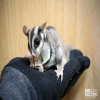Petaurus breviceps
In the sugar glider, the head & body length can vary from 5 to 12.5 inches; tail length from 6 to 8 inches, and weight from 3 to 5 ounces. The fur is fine and silky. A dark dorsal stripe runs from the nose to the rump, and there are stripes on each side of the face from the nose through the eye to the ear. A gliding membrane extends all the way from the outer side of the forefoot to the ankle, and is opened by spreading the limbs straight out. Females have a well-developed pouch during the breeding season. The number of mammae is usually 4, but occasionally 2. Sugar-gliders are shy and inconspicuous, having little reflective eyeshine and the ability to move quickly. They exhibit a complex social system, which varies somewhat according to the type habitat in which they live. The basic social unit consists of 2 to 7 adults (typically 5 to 7) – 2 or 3 adult males and 3 or 4 adult females. Group members share a tree hollow in which they build a spherical or bowl-shaped nest of eucalpyt leaves, but they generally forage alone at night. Group membership is closed to outsiders unless a vacancy is created by the death of a member. The dominant male in each group marks other group members with secretions from his head and chest scent glands. There are a variety of calls, including a loud bark or ‘yip’, and a rolling ‘starter motor’ anger call. Juveniles make a hiss when threatened, and will be assisted by any adult member of the same group. Small isolated wild populations are vulnerable to predation, particularly by cats.

